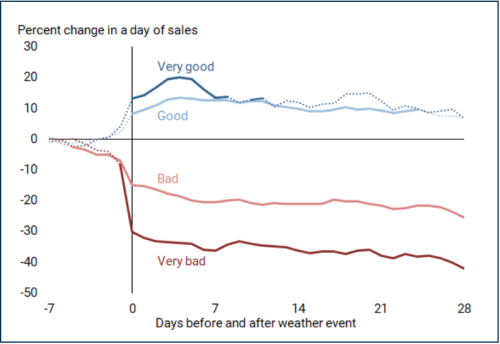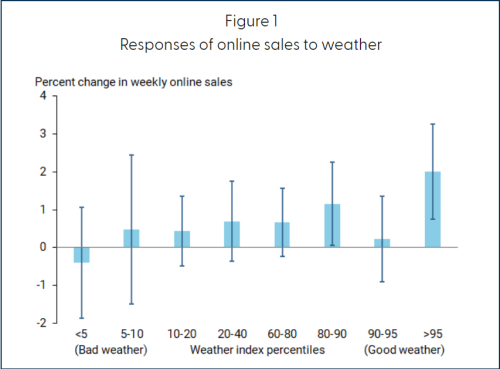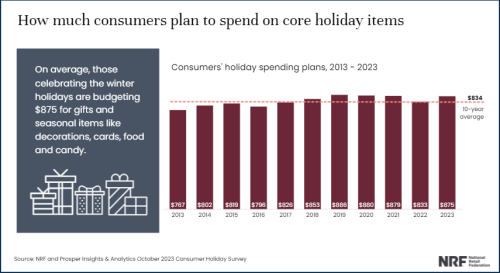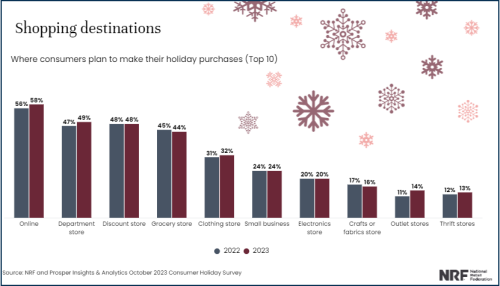Weather has always played a crucial role in shaping the retail landscape and can have a significant influence on retail sales and operations. Extreme weather events like heat waves, cold snaps, hurricanes, and blizzards can keep shoppers away and disrupt supply chains but equally important is the panic buying that occurs prior to any extreme or severe weather event. A great example is the panic buying in advance of a Nor’easter in New England – you literally cannot find a roll of toilet paper or commodities such as milk on the shelves. Even more moderate weather has been shown to impact purchasing behavior. As retailers develop more data driven sales demand forecasts and supply chain strategies, accounting for weather is crucial.
However, even good weather can disrupt product demand and inventory, as the impact of weather can go both ways. A noteworthy surge in retail sales this past January was attributed to exceptionally warm weather, surpassing expectations at 3.2%, as reported by CNN. However, the narrative took a turn in March when U.S. retail sales experienced a steeper-than-anticipated decline of 1%, more than doubling the forecasted 0.4% dip according to USA Today, which they say is the result of a weather-induced buying spree, possibly panic buying, early in the year. In addition, unexpected or severe weather can also disrupt inventory and product sales, leading to issues such as stockouts that can be a source of customer frustration or overstocks which can have a significant impact on retail revenue.
Weather and Demand
According to ResearchGate, “analyzing daily sales at a national apparel and sporting goods brand’s stores reveals that weather’s effect on store sales are surprisingly persistent, even after accounting for shoppers simply changing when and where they make their purchases. Moreover, sales at stores that have more experience with adverse weather events have a lower response, suggesting that adaptation may reduce the negative impact of increasingly severe weather on sales.”
Their findings demonstrate the importance of accounting for weather when analyzing the impact of weather on retail sales. Weather variables, such as temperature, play a significant role in consumer behavior and can mediate the relationship between weather variables and sales. Ignoring weather can lead to misleading conclusions and inaccurate predictions of sales. Research underscores the importance of incorporating weather as a serious data point when assessing the influence of weather on retail sales – various factors influence sales, encompassing allocated shelf space, quantity purchased, promotional activities, store brand, competition, temperature, and the annual frequency of purchase.
Weather has a clear impact on retail sales over time. In the graph from FRBSF, solid lines represent average estimates within the 95% confidence range for statistical significance, while dotted lines indicate estimates not significantly different from zero. The blue lines show that the initial positive effect of good weather may be partly offset by later declines in sales, becoming statistically insignificant four weeks after the weather event. In contrast, the red lines demonstrate that the impact of bad weather on sales endures and persists over time. Although the initial surge in sales due to good weather might diminish in the following weeks, the immediate downturn in sales caused by bad weather persists and is not offset over time.

Shopping Environments
In addition to the direct impact of weather on retail sales, it’s also reshaping the shopping experience and posing challenges to store accessibility. The Federal Reserve Bank of San Francisco (FRBSF) has extensively examined this variable finding that “when weather is good for shopping in stores, indicated by a high weather index value, online sales actually increase. This finding could be explained by weather affecting underlying demand for particular products or if shopping in stores leads to online orders for specific sizes or colors of products that are not in stock.”

Weather plays a role in shaping the enjoyment of the shopping experience compared to other activities. For instance, a visit to an air-conditioned enclosed mall can be a more enjoyable activity on hot or rainy days. Conversely, during pleasant weather, outdoor malls may become preferred destinations for shoppers. If the selection of the shopping environment is weather-dependent, weather events may prompt a shift in sales between indoor and outdoor stores.
Trends
The impact of weather was definitely felt in 2022. A severe cold snap in Texas in February 2022 left grocery stores with empty shelves amid disrupted deliveries and surging demand for cold weather staples. Retail analytics firm Sensormatic found a nearly 30% drop in physical store traffic during the two weeks of frigid temperatures compared to other winter periods.
Data from the 2022 holiday shopping period also demonstrates weather’s influence. Fair weather on Black Friday weekend boosted foot traffic and sales around the country compared to the previous rainy year. Then winter storm Elliot hit, the storm kept shoppers at home and also hit Dollar General with inventory damage, for instance, according to Supermarket News. Their fourth quarter same-store sales were up just 5.7%, which is below the company’s projection of 6-7%. In December, when Elliott wreaked havoc, same-store sales were 4.5%. Dollar General was looking at FY 2022 increases of 4-4.5% for same-store sales, and actual data came in at 4.3%.
Although final numbers are still out for 2023, there are some insights available. Knight Frank cited that in March, year-over-year retail sales values demonstrated a notable increase of 6.0%, although volumes experienced a contrasting decline of -3.2%. Quarter-over-quarter trends portrayed a more positive picture compared to month-over-month results. However, March saw a dip in month-over-month values (-0.6%) and volumes (-1.0%). They attributed the underwhelming performance in March to adverse weather conditions, while soft demand for ‘big ticket’ items further impacted the retail landscape.
Looking at the 2023 holiday shopping season, the National Retail Federation predicts a strong holiday season with sales potentially growing by up to 10% per consumer compared to last year, reaching an estimated total of $833. This exceeds the 10-year average. Over the past decade, consumers have been starting their holiday shopping early to manage budgets and avoid last-minute stress. This year, 59% of holiday shoppers began browsing and buying by early November.


The Solution
By factoring in weather and various elements, retailers can conduct more precise assessments of how weather influences product sales. This, in turn, enables the development of well-informed marketing and sales strategies, ultimately contributing to enhanced business performance and increased customer satisfaction. Having hyper-local insights down to the store level allows for the alignment of staffing levels, supply needs, and promotional strategies with anticipated store traffic and demand shifts influenced by weather at each location. Advanced notice facilitates necessary adjustments ahead of severe storms and integrating weather intelligence into business operations can drive significant value for retailers and prevent situations such as stockouts.
Businesses who are not using weather data as part of their demand forecasts routinely report overstock or stockout lost revenue up to 3% of total revenue. Acknowledging this discrepancy, Weather Source has developed the world’s most advanced weather-based demand forecast tool, our Weather Insights Platform (WIP). WIP powers multiple multinational retailers and large restaurant chains with ML-driven weather-based demand forecasts with predictions going out from days all the way out to a year.
WIP not only provides demand forecasts, it also generates historical impacts and actionable insights that provide retailers, restaurants, grocers and more a competitive edge by significantly reducing stock-outs and overstocks. Many businesses are just getting started in understanding how weather influences their business and sales. Leveraging WIP ensures that your team’s daily decisions are guided by actionable weather insights, providing valuable support for:
- Product Selection and Forecasting
- Seasonal Display Adjustments
- Product Rotation
- Staffing
- In-Store Promotions
- Inventory and Replenishment
- Weather-driven Advertising
Weather Source is excited to attend the National Retail Federation’s NRF2024: Retail’s Big Show happening January 14-16 in New York where we will be doing live demos of WIP in action. Explore firsthand how to unleash the potential of weather with WIP, transforming it into your most valuable asset and elevating your operations, supply chain, and bottom line. Contact us to learn more or to schedule an in-depth meeting during the show.



